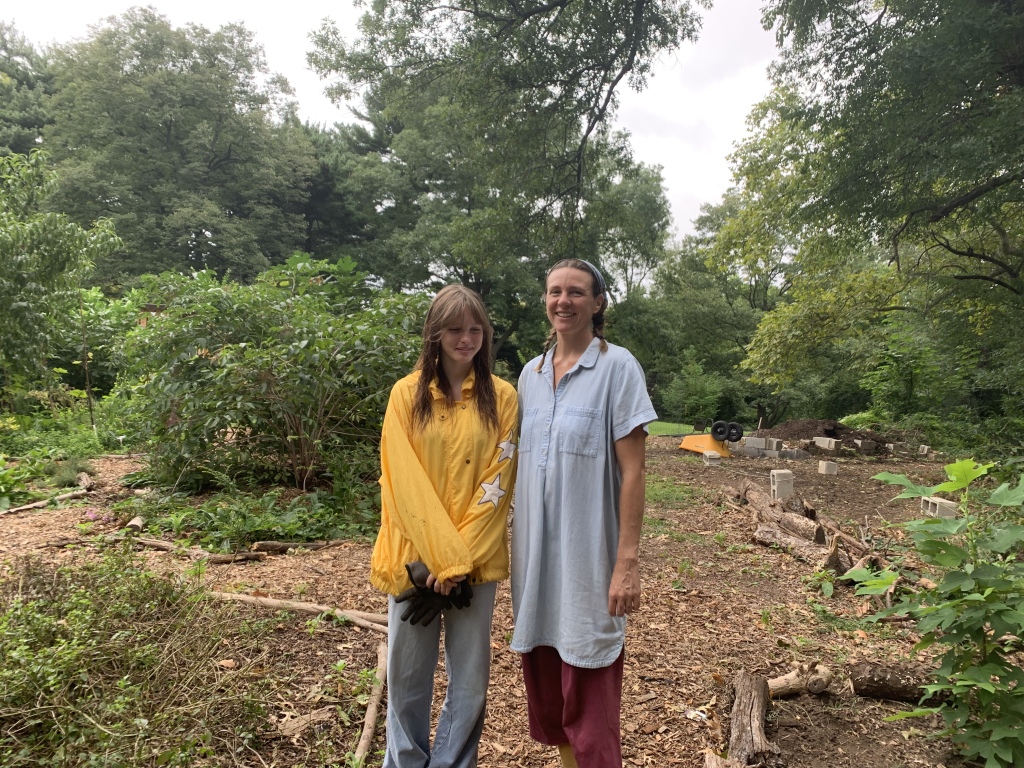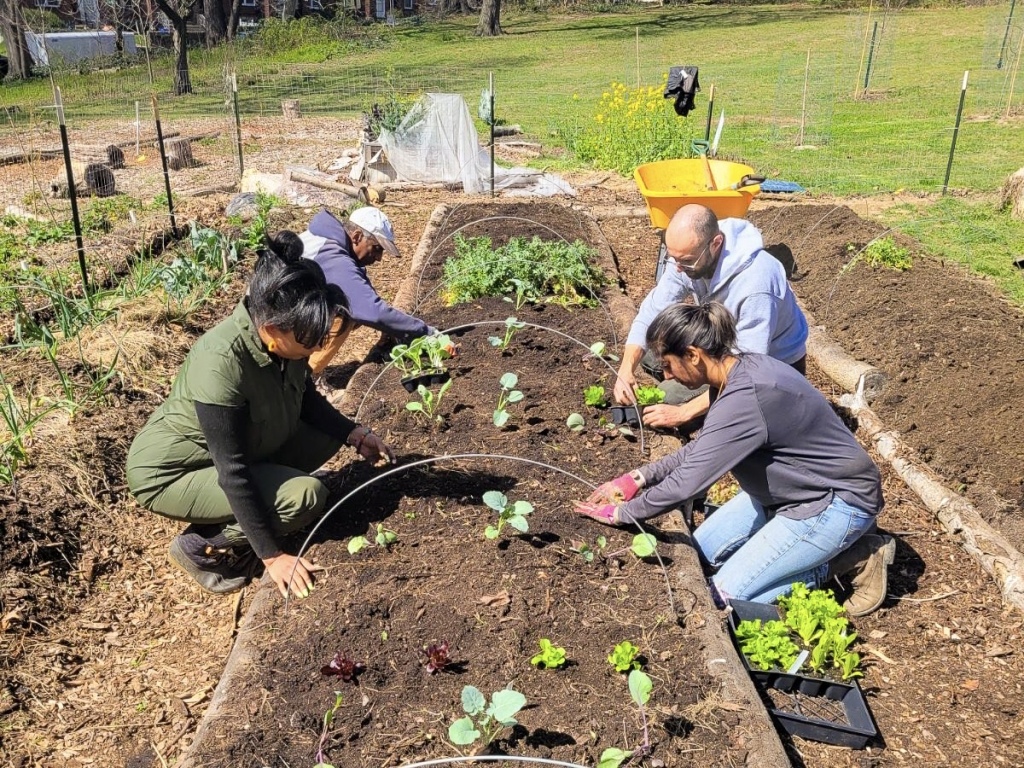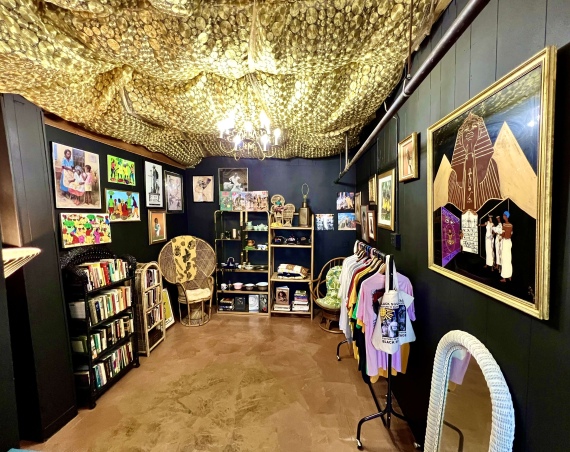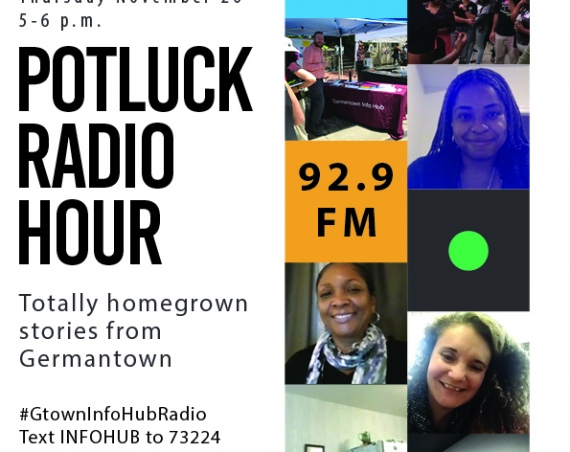
When you enter the rather large Fernhill Park in Southwest Germantown, you can see there is a lot of land. Trees, a basketball court, tennis courts, a baseball field at the further end down near Roberts Avenue, another smaller baseball field in the upper part of the park near Morris Street, playgrounds, and even an entire kid-sized circular track built for bikes and scooters all sit within the 51 acres.
There’s a big hill that folks use for sledding in the winter. There are places to hide and places to seek. It has the space for a lot of outside activities to happen.
The Friends of Fernhill Park have been trying to activate many of the spaces of the park, including a biking club, an art club, a summer camp, and a Fun Fridays summer series. One of the many community-led activations that has had a lot of involvement is the Food Forest.
What is a food forest? According to the Philadelphia Orchard Project, the concept is inspired by permaculture design and Indigenous traditions. It is a growing system designed with layers like a forest to produce food we can eat.
Back in 2020, a nearby neighbor to Fernhill Park, Jaron Olevsky, started planting things out of wanting to get out of the house and grow things. He was new to it and learning, so he didn’t exactly know what he wanted to do.
He knew he wanted other people involved but didn’t know how that might happen. He knew that as he learned more about growing, he wanted to follow permaculture principles and plant more perennials and other foods that could be offered freely to neighbors.
As he experimented with growing in the park, he asked the Friends of Fernhill Park if they would be interested in planting trees. They were receptive, and with some funding and consultation from Michael Muehlbauer, who worked with the Philadelphia Orchard Project and was helping with a food forest in Fairmount Park in the fall of 2021, they planted the first set of fruit trees.
Olevsky kept planting things, taking care of the new trees, and meeting people that he said “weren’t afraid to talk to him” while working in the park.
One of them was his neighbor Mekia Elizabeth, chair of the Friends of Fernhill Park, who met Jaron in 2022 when the food forest was still in its baby phase. She calls him a mad scientist. She said his willingness to explore and experiment made her comfortable to also get down in the dirt and grow things from seed for the first time.
“It really gave me courage to try. I had never planted anything. I planted my first seed with Jaron, so I started calling him our food forest father because things just grow in his presence,” said Elizabeth.
As a musician, Olvseky travels a lot in the summer. And those travels brought neighbor Sumi Narra into the fold. They had run into each other outside as Narra would walk her dog throughout the neighborhood.
There’s a lot of watering involved in caring for newly planted trees, and she offered to help take 35-gallon tanks, fill them with water at her house, and drive them into the food forest a couple of times a week throughout the summer so the baby trees would survive. And she’s been a core volunteer ever since.
Next to join the core crew was Sunni Bell. Originally from Alabama, Bell moved up to Philly and met Mekia Elizabeth at the Germantown Arts District Festival.
Bell brought an extensive knowledge of organic farming, taking over vacant lots, and planting in ways that make sense with the land. But the Fernhill crew also feels that Bell’s addition brings more value in other ways.
“In addition to growing food, Sunni has been growing people and peoplehood around in our community,” said Elizabeth about Bell’s community-building skills.

This skill was displayed during one recent garden volunteering day where Bell read a land acknowledgment inspired by her friend in the south whose mission is to acknowledge land in every part of the country.
An excerpt of the land acknowledgment reads as follows:
The Fernhill Food Forest is a guest on the unceded, ancestral homeland of many indigenous sovereign nations, tribes, and communities. In saying their names, we honor their stewardship of this land and call ourselves forward to being better stewards of the land and waterways here in what is now known as Pennsylvania. We thank the Lenape, Susquehannock, Shawnee, and Iroquois. Whose names have been erased by colonialism, genocide, and displacement. In harmony with honoring the land, Fernhill Park also honors and acknowledges the great Lenapewihittuck, now called the Delaware River, Manayunk, which we call the Schuylkill River, and Wissahickon Creek… Land Acknowledgements are a call to action and a reminder to be better ancestors while we inhabit this beautiful place in the world.
Elizabeth felt the power of the land acknowledgment, along with the other adults, who she says cried. She also said she could see all the children gathered, put their hands to their hearts, and take in the message in a way she’d never seen before.
Honoring and acknowledging the land includes removing invasive species and growing native and pollinator plants such as comfrey, borage, and yarrow. Plantings of perennial vegetable and herb plants were strategically added. There’s a pumpkin patch. All were done intentionally to help build the layers of the forest.
However, strategic and sustainable planting is not the only important part. The community-led project knows it is also important to produce plants and food that neighbors can actually use and eat.
According to Feeding America’s research, Philadelphia had a food insecurity rate of 15.2% in 2022, with many food-insecure people making too much money to qualify for SNAP benefits. Food Forest volunteers ideally want the project to help food-insecure families fill the gaps.
And, of course, there’s the relationship building. For his part, Olevsky can’t believe that he has found such a community of people in this work and has met so many of his neighbors because of it.
Darren Berry Jr. is a nearby neighbor. He has regularly brought his kids to the park, and he had seen Olevsky working there, so he became curious. When Olevsky showed him around and told him what they were doing, he was very supportive.
He likes learning about the whole process and “knowing what’s being put into the seeds and the soil.” But more importantly, he feels it can be a powerful tool for people in need and the general community.
Another neighbor, Xavier Chanet, is new to the area. He’s been enjoying having such an accessible way to connect to nature in deeper ways. There was one community work day when he was in the forest on his own, and a neighbor showed up with children. Because of the welcoming and inclusive example, the core crew has set up in the forest, Chanet felt comfortable showing the children around and introducing them to some of the growing plants.
“I feel like the whole crew really places a high value on paying attention to nurturing children, learning about the gardening and the food, and to the point where, you know, I felt kind of inspired,” said Chanet.
Narra and others form partnerships all around the community to support the forest, like co-op hours with Weavers Way Co-op to allow working members to get their volunteer hours for volunteering in the food forest and volunteer student work days with Germantown Friends School, Wissahickon Charter School, and Penn Charter.
They’ve worked with POWER Corps, which pays young people to work on community-based projects throughout the city. Some POWER Corps workers helped with the garden’s mulch and other manual labor.
The core crew stressed that it had been a lot of labor to get this project going. They have brought in loads of mulch, gallons and gallons of water, and partnered with many folks to ensure weeding and regular forest maintenance was happening.

Getting materials for the forest was a mixture of buying things on their own, says Narra, and most recently, a few items bought with grant funding. Narra applied and received money for a microgrant from a state agriculture program. They purchased a hydrant device that lets you connect a hose to a hydrant and two sickles to cut down vegetation.
Olevsky applied and received a small grant from the Awesome Foundation. He has used different funding sources for annual bed fencing and T-Posts. He says he would love to see more of the expansive land in the park being used for Food Forest growth.
“But we all, I think collectively, want this to be a place where we can focus on ecosystems and stewardship and, and like, a different view of what growing edible plants can look like. And that it’s a very different approach than community gardens with individual plots,” said Olevsky.
Bell agrees, and as a team, they are trying to move forward with the food forest in a way that prioritizes a natural give and take with the soil, where the land isn’t just harvested but enriched.
“Our whole thing is not just to be a sustainable, organic growing space, but, in fact, to be stewards. And that is not sustainable; it’s regenerative. Not only do we sustain, we give back. And the way that we plant and grow gives back as well,” she said.
You can contact the forest by emailing Fernhillfoodforest@gmail.com. Anyone can help volunteer in the food forest, and they have open volunteering hours every Saturday from 10 a.m. to 12 p.m.



